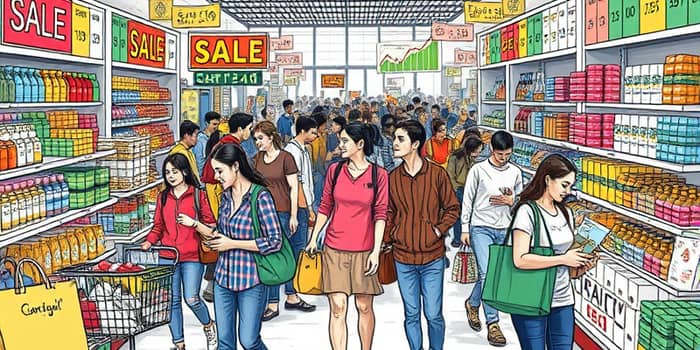
In mid-2025, American households have walked a tightrope between cautious optimism and persistent worry. While consumer confidence edged back to 98.0 in May, it remains shadowed by rising concerns over inflation and job markets. This article dives into the key drivers behind mixed sentiment and outlines how businesses and individuals can navigate the shifting landscape of spending decisions.
After five straight months of decline, the US Consumer Confidence Index rebounded by 12.3 points in May 2025. The Present Situation Index rose notably, climbing to 135.9, and the Expectations Index surged 17.4 points to 72.8. Despite this boost, sentiment still hovers below the critical 80 mark that typically signals robust economic outlooks.
The rebound was fueled in part by a pause in some US-China tariffs, which eased fears of escalating trade tensions and stabilized key supply chains. Yet June data showed renewed weakening, erasing about half of the recent gains. Consumers’ appraisal of job availability has declined for the fifth month running, adding to overall uncertainty around hiring and wage growth.
Experts warn that confidence can be fragile. Even small policy shifts or geopolitical events can quickly shift the narrative, reminding businesses to stay vigilant and adaptable in their forecasting and inventory planning.
Shifted spending habits reveal a complex consumer psyche. Roughly 79% of shoppers worldwide are “trading down,” not by buying fewer goods but by hunting deals across priorities. Nearly half of US consumers plan to delay major purchases in the coming quarter, and promotional events drive choices more than ever.
Deal-seekers are leveraging technology to optimize their spend. Mobile coupon apps, browser extensions, and social media deal groups are booming. Consumers track price drops obsessively, and brands that fail to match competitor promotions risk losing market share in a fiercely competitive environment.
Still, many households cling to ongoing inflation pressures on essentials, they maintain small luxuries that deliver emotional uplift. Streaming services, specialty coffee, and eco-friendly personal care products remain steadfast in consumer carts.
Generational splits highlight diverging priorities. Gen Z and Millennials saw spending jump 5.9% month-over-month in May, outpacing other cohorts. They increasingly favor sustainability, experiences, and digital convenience, forming a potent growth engine for brands that can meet those expectations.
Within these groups, personalized digital experiences matter. Chatbots, virtual try-ons, and seamless mobile checkout flows drive engagement. Younger consumers are more likely to adopt new payment methods such as Buy Now, Pay Later, and digital wallets, reflecting their comfort with innovative financial tools.
Conversely, older consumers exhibit more caution. With reported income gains tapering and savings withdrawals rising, they are more conservative in discretionary spending. This cohort’s heightened focus on inflation risks underscores a need for tiered strategies that address both value and premium segments.
To capture diverse cohorts, businesses must blend digital and traditional channels. A multichannel approach that balances personalized online outreach with in-store experiences will resonate across age groups.
Environmental stewardship is no longer a niche concern. Some 58% of consumers will pay more for eco-friendly products, with Millennials and Gen Z leading at 60%. A significant 43% demand clear sustainability reporting and transparency from brands.
Companies that weave environmental initiatives into their core identity can leverage this shift. By showcasing verifiable actions—such as reduced packaging, renewable sourcing, or carbon offsets—they can deepen loyalty and justify premium pricing. Brands that remain vague risk consumer backlash and reputational damage.
Case studies abound of companies benefiting from sustainability pivots. A sustainable apparel line that uses recycled materials can command higher price points while reducing production costs, illustrating how green practices can align with profitability goals.
This snapshot underscores how small shifts in confidence and spending can yield meaningful impacts for the year ahead.
In an era of deal-hunting, loyalty is a delicately earned privilege. More than half of consumers cut spending with a brand after a negative experience, while improving customer ratings from 1–2 stars to 3 stars can boost repurchase likelihood by 68% and recommendations by 97%.
Brands must deliver consistent, value-defined by deal-seeking flexibility and personalized service to sustain engagement. Loyalty programs that offer tiered benefits and timely rewards can capture the hearts—and wallets—of cost-conscious consumers. Incorporating feedback loops and real-time issue resolution fosters trust and long-term partnerships.
Moreover, brands embracing co-creation—inviting consumers to shape products and campaigns—can cultivate deeper loyalty by making shoppers feel heard and invested in the brand’s success.
While spending growth remains resilient, businesses face potential headwinds. Rising goods inflation could erode real incomes, and the possibility of a future recession still lingers. Political developments, global supply chain disruptions, and renewed trade tensions can swiftly alter consumer psychology.
Industry leaders should prepare multiple scenarios: one for sustained moderate growth, another for a mild downturn, and a third for aggressive inflation. Stress-testing pricing models and supply chain resilience will be critical to weathering unexpected shocks.
Individual consumers, too, can benefit from a proactive stance. Building an emergency fund for unexpected shocks, diversifying income streams, and upskilling in high-demand fields can enhance personal financial stability in uncertain times.
Ultimately, mixed confidence presents a dual narrative: cautious consumers who still crave moments of joy and businesses striving to decode shifting signals. Recognizing the nuanced motivations behind spending can help companies innovate and individuals make informed choices. As we move deeper into 2025, the most agile brands and financially savvy consumers will be the ones to thrive in a landscape defined by both uncertainty and opportunity.
References













